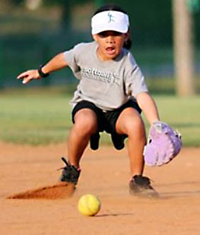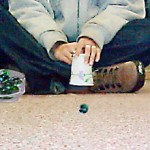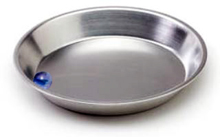Tracking: Pursuits
 Pursuits is the skill that allows our eyes to smoothly follow moving targets. This is an especially important skills in most sports, allowing us to catch, hit, or kick a moving ball.
Pursuits is the skill that allows our eyes to smoothly follow moving targets. This is an especially important skills in most sports, allowing us to catch, hit, or kick a moving ball.
Evaluation: Hold a small target 16-18 inches in front of the child’s eyes. A small sticker on a stick is a good target. The goal is to have the child follow the sticker without jerky eye movements or aiming errors. Move the target left-right, up-down, forward and back, and then in circular motions—starting with small movements and working to larger. Watch the child’s eyes. Do they jerk, jump, or move off the target? Does his accuracy falter in certain positions of gaze? How quickly do he correct? Does he move his head? Does he have unnecessary body movements? Is he tense, rigid, wiggly, or need encouragement to complete the task, indicating the effort he must exert? Does accuracy degenerate with time? If the child struggles with this task, then working the exercises on this page will help improve pursuit skills.
Helpful Hint: If head movement is a problem for the child, place a bean bag or stuffed toy on his/her head as a reminder to hold the head still.
- Click on this link to go to the exercise. Bug Walk
- Keep your eye on the bug as he walks across the screen.
- Parents: If your child has trouble doing this exercise with both eyes, have him/her cover one eye. Continue to work this activity with one eye at a time until performance improves; then work both eyes.
- Bring It Home: Add a cognitive demand to the activity. Say a girls name that starts with A, then a boys name. Continue through the alphabet.
- Click on this link to go to the exercise. Bug Run
- Repeat the exercise as above, but this time the target will be moving faster.
- Place a marble in a pie pan and rotates it with circular motions on the outside rim.
- Move only your eyes, not your head.
- For this activity, you will need a ball that swings from the ceiling. A tennis ball with a tea cup hook works well.
- The ball should be at eye level. Stand 2 feet in front of the ball with your feet about shoulder length apart,
- Swing the ball from side to side like a pendulum.
- As you watch the ball moves from side to side, your head and body should remain still; only your eyes should move.
- Next, swing the ball the opposite direction, away and back in towards you. As the ball approaches, reach out and gently touch the ball when it is directly in front of you.
- Parents: If your child has trouble doing this exercise with both eyes, have him/her cover one eye. Continue to work this activity with one eye at a time until performance improves; then work both eyes.
- Bring It Home: Repeat the exercise while balancing on one foot or standing on a balance board.
- In a darkened area, shine a flashlight around the room–on the floor, walls, and ceiling.
- Include smooth movements as well as jumps in the pattern.
- Have your child shine a second light directly on the your beam.
- Work on the child’s accuracy in following the lead beam. Go slowly at first and then increase speed.
- Parents: If your child has trouble doing this exercise with both eyes, have him/her cover one eye. Continue to work this activity with one eye at a time until performance improves; then work both eyes.
 Sit on the floor 8-10 feet across from your child.
Sit on the floor 8-10 feet across from your child.- Roll marbles to the child one at a time.
- The child watches the marble as it approaches and traps it under a cup brought straight down over the rolling marble to capture it underneath.
- Marbles that are caught are placed in one bowl while those which are missed are placed in another.
- As the child progresses, roll the marbles more quickly and at varying angles.
- Not only is this excellent training, but young children enjoy this game, particularly when they can tangibly monitor progress as the marbles in their “caught” bowl increase.
ARE YOU READY TO START VISION PERCEPTION EXERCISES?



